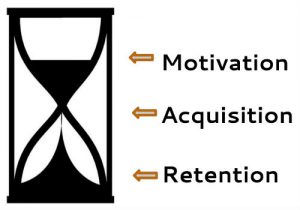What does the term “teacher as facilitator”  really mean? Facilitating learning is what adults do naturally with young children. The parent observes the child and starts asking questions and making connections. When a child grabs a blue block, the parent says, “blue,” perhaps followed by “What else is blue?” pointing to multiple items that are blue. Then the parent moves on to another color. Meanwhile, the child is grappling with what makes those blue items different from these red items, and learning follows. If the sky grows dark with clouds, the parent may ask what that means and then follow with the idea that it means rain may be coming. The next time dark clouds appear, the parent prompts the child with a question as to what that means. Teachers need to mirror this process while facilitating learning at all levels.
really mean? Facilitating learning is what adults do naturally with young children. The parent observes the child and starts asking questions and making connections. When a child grabs a blue block, the parent says, “blue,” perhaps followed by “What else is blue?” pointing to multiple items that are blue. Then the parent moves on to another color. Meanwhile, the child is grappling with what makes those blue items different from these red items, and learning follows. If the sky grows dark with clouds, the parent may ask what that means and then follow with the idea that it means rain may be coming. The next time dark clouds appear, the parent prompts the child with a question as to what that means. Teachers need to mirror this process while facilitating learning at all levels.
While teachers will gather formative assessment data during facilitation and ensure that students are on task, the most important role in the facilitation process is helping students to learn. In the Learner-Active, Technology-Infused Classroom, much of the facilitation process involves teaching! When you enter the room, it should be difficult to find the teacher, who is invariably sitting among the students teaching through facilitation.
The “learning hourglass” (introduced in It’s Not What You Teach But How) depicts three stages of learning that should be addressed during facilitation.

Creating a “Felt Need” to learn: The first step is to ensure the student is motivated to learn the content. We learn best when we feel a need for a skill or concept. When you sit next to a student to facilitate learning, determine if s/he is ready to learn the next skill or concept. If so, you might ask a “What if?” question to trigger awareness on the part of students. For example, if a student is adding up pennies, you might ask what would happen if you took ten pennies and gave him a dime? He wants to make sure he’s not being cheated, so he has a “felt need” to figure out if it will be the same or not.  If a student has determined that photosynthesis is the process through which plants produce energy, you could ask, “So how do you think the process is affected when you have a pine needle versus an oak leaf?” The key to teaching is to trigger a felt need so that the student’s brain is more likely to engage in learning.
If a student has determined that photosynthesis is the process through which plants produce energy, you could ask, “So how do you think the process is affected when you have a pine needle versus an oak leaf?” The key to teaching is to trigger a felt need so that the student’s brain is more likely to engage in learning.
Acquisition: The brain learns by making connections to existing knowledge. If I know how to add, then the successive addition of the same number of items leads me to the concept of multiplication. In order to construct meaning, students need to “grapple” with content, exploring in terms of what they already know, identifying gaps in what they know, and figuring out what they don’t know. For example, if you understand the economic concepts of supply and demand, you might engage in a simulation where you realize that some product sales remain steady in spite of price changes (such as food  and gas) while for other products, a price increase causes a drop in demand, because people view these products as a luxury. Thus, you begin to understand the concept of elasticity. It’s important to lead students to grapple with content by asking them questions, for example: “Even though the price of milk went up by fifty cents a gallon, the store is selling just as much. Why do you think that is?” If a student is struggling with a skill or concept, you might suggest other learning resources such as a video, a learning center, or attending a small-group lesson. IDE Corp.’s Five Levels of Facilitation Questions can offer suggestions for asking questions that move toward higher academic rigor. The key is to help lead the student to learning.
and gas) while for other products, a price increase causes a drop in demand, because people view these products as a luxury. Thus, you begin to understand the concept of elasticity. It’s important to lead students to grapple with content by asking them questions, for example: “Even though the price of milk went up by fifty cents a gallon, the store is selling just as much. Why do you think that is?” If a student is struggling with a skill or concept, you might suggest other learning resources such as a video, a learning center, or attending a small-group lesson. IDE Corp.’s Five Levels of Facilitation Questions can offer suggestions for asking questions that move toward higher academic rigor. The key is to help lead the student to learning.
Retention: Once the student “gets” a skill or concept, it’s important to ensure s/he engages in practice and application in order to increase retention. Ask questions that prompt applying content to a different situation. Look for opportunities to refer back to previously learned content. For example, as students learn about literary devices and find out that metaphors and similes are examples, ask to what other category they belong, to reinforce the concept of figurative language. The key is to help ensure that the learning is retained.
Print out a copy of this Guide to Facilitating Lasting Learning to use as a reminder during facilitation. The Facilitation Roadmap is also a helpful tool for identifying how to help a student learn.
So, sit down with a student, facilitate learning, and change the world!
